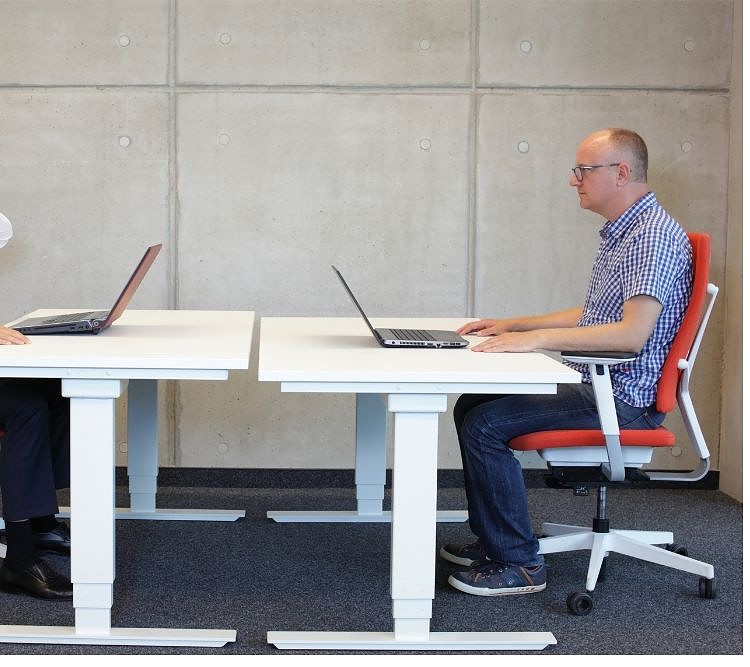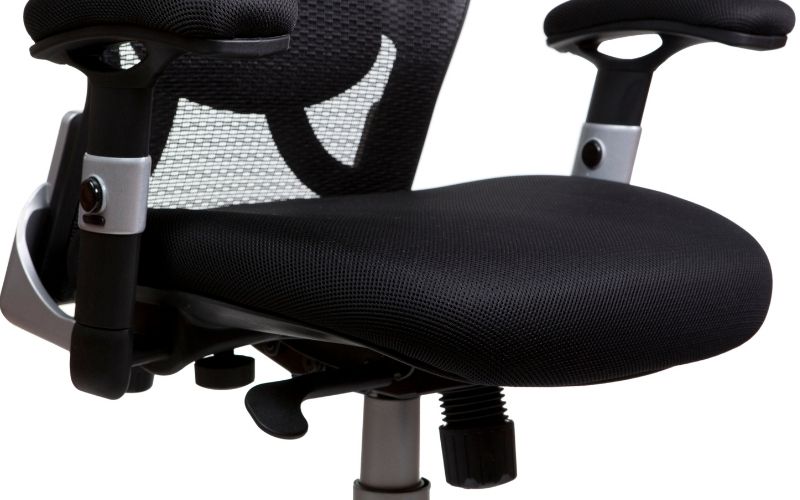Without ergonomic chairs, productivity in the modern office wouldn’t be possible.
Adjusting proper seat height to ensure maximum comfort makes it possible to work eight to nine hours a day, five days a week, with little to no back and neck pain.
To adjust pneumatic office chair depth, locate the depth adjustment knob at the bottom left of your office chair. This should cause your chair seat to move inward and outward. The Ideal chair seat depth leaves two to four inches between the back of your knees and the front of your seat.
Failure to adjust proper seat depth will lead to poor posture and lumbar support. Your legs won’t have enough circulation either.
To find the ideal office chair position and ensure proper circulation, you need to adjust seat depth and height.
You should be able to sit comfortably with your back firmly against the backrest, feet flat on the ground, and your knees at a 90-degree angle.
Office chairs are indeed a staple of office life, but how do they work? Learn the proper way to adjust the seat depth to find optimal comfort and productivity in your workspace.
Table of Contents
- How does office chair adjustment work?
- What is an office chair seat slider?
- Why do I need to adjust the depth of my office chair seat?
- How do I measure office chair seat depth?
- How do I find proper office chair seat depth and height?
- Step-by-step guide: How do I adjust office chair seat depth?
- Conclusion – Adjusting Office Chair Depth
How does office chair adjustment work?

Pneumatic office chairs have numerous features to ensure good ergonomics.
Chair seat height is adjusted with an air cylinder, and seat depth can also be adjusted by moving the seat pan.
Office chairs have a single-acting cylinder that acts as a spring to adjust the height. This cylinder contains an air chamber connected to a piston that can be activated by a lever or knob. Moving the piston into or out of the chamber compresses air, determining chair seat depth.
The cylinder makes the lifting motion convenient and easy. You’ll have to manually move the chair seat depth and use a pin to stabilize the height without it.

To lower office chair depth, pull the knob while adding weight to the seat. To elevate an office chair, pull the same knob without adding weight to it.
Your gas cylinder is likely broken if your office chair doesn’t go up after pulling the lever or knob.
Finding a replacement online and installing the spare is relatively easy.
What is the knob at the bottom of the office chair?
The knob that sticks out below your office chair is most likely connected to the lever that adjusts the piston. Pulling the knob activates the piston and moves it into the air chamber. This action compresses the air inside the cylinder, causing your office chair seat to lift.

Removing the piston from the chamber causes the air inside the chamber to expand, lowering the seat.
To find the chair depth adjuster, locate the lever on the left side of your office chair.
What is an office chair seat slider?
An office chair seat slider will allow you to adjust your office chair depth or the distance between your seat and the chair’s back.
Seat depth adjustment ensures that you have enough lumbar support and good posture.
You need enough chair depth, height, and width to sit comfortably. The exact number will vary according to your height, but the ideal office chair seat depth is between 17 to 20 inches. This seat depth should be enough so that you’re able to leave at least two to four inches of space between the back of your knees and the front of the seat.

Why do I need to adjust the depth of my office chair seat?
Not all office chairs have the feature of an adjustable seat slider to find optimal chair depth. Office chair companies usually cut manufacturing costs by eliminating this feature.
However, adjusting seat depth is incredibly important to ensure that you are comfortable, have good posture, and prevent damage to your spine and muscles.
Having the proper office chair seat depth will prevent:
- Knees too close to the chair: Contact stress on your legs and cuts off circulation
- Knees too far from the chair: Lower back is not supported
Conversely, it’s also important that you adjust chair seat height along with chair seat depth. You won’t be able to find the most ergonomic seating position without the other.
How do I measure office chair seat depth?
Seat depth determines how long your seat will be.
When seated, your hips should be far back into the backrest. Seat depth measures the length from the backrest to behind your knees.
How do I find proper office chair seat depth and height?

Before you can begin adjusting your chair seat depth, let’s understand office chairs from an ergonomic standpoint.
Pneumatic chairs are built with an optimized position in mind, lowering the risk of the negative health consequences of being seated for an extended period at a time. You can suffer back, neck, shoulder, thigh, and arm pain from using the wrong office chair!
By finding the ideal office chair height and depth, you’ll be able to work comfortably and boost overall productivity.
To find the ideal office chair position, you should consider the following factors:
- Feet firmly planted on the floor
- Knees are bent at a 90-degree angle
- Knees two to four inches away from the seat
- Back firmly on the recliner

If you’re working on a computer, consider these additional factors when adjusting:
- Elbows should be at a 90 to 110-degree angle
- Forearms should be parallel and at the same height as the desk
While it can be tricky to balance these factors, finding the ideal office chair height isn’t impossible.
Poor sitting practices cause extreme stress that can damage posture, which is why many office workers opt to get additional lumbar support aside from adjusting seat depth and height.
Step-by-step guide: How do I adjust office chair seat depth?
Adjusting office chair depth isn’t as simple as you think. There’s more to pulling the lever making your seat go inwards and outwards. You have to think about the proper office chair seat position, including appropriate seat depth and height.
Hopefully, you didn’t throw away your office chair manual either. To properly adjust your office chair, you’ll need to familiarize yourself with office chair parts and lever types.
From there, you can begin adjusting chair seat depth and test it to see if you’ve found the ideal chair position.
Step 1: Place the office chair in front of your work desk.
Are you setting up your home office? Ideally, you’ve already figured out the desk or table you’ll most likely be working on.
This step will make adjusting your office chair depth according to your height, and back support needs, easier.
Step 2: Familiarize yourself with your office chair adjustments and levers.
Your office chair was built to help you find the most ergonomic working position, hence the multiple adjustment levers for chair tilt tension, back height, seat angle, seat height, and seat depth.
The one you’ll need to adjust your office chair depth will most likely be located at the bottom left side of your office chair.
To adjust chair seat height, you’ll need to pull the lever that activates the gas cylinder (causes lifting motion).
Step 3: Adjust chair seat depth.

There are two ways to adjust chair seat depth:
Method 1: Stay seated and pull the seat slider or depth adjustment lever until your back is firmly on the backrest and your knees are two to four inches away from the edge of the chair seat.
Method 2: Adjust chair seat depth while standing. Adding less weight on an office chair during adjustments causes less wear.
Step 4: Test chair seat depth and height.
Carefully sit down on the office chair once you’ve adjusted it to the proper depth and height.
You should have your back firmly on the backrest, with both feet flat on the floor with your knees slightly lower than your waist, at least two inches away from the seat, and bent at a 90-degree angle.
If needed, repeat step three until you find the ideal office chair seat position.
Step 5: Lock the chair seat position.

With most pneumatic chairs, the chair position will lock automatically once you release the lever.
However, you’ll need to secure the locking mechanisms with older models before placing your full weight on the chair.
Conclusion – Adjusting Office Chair Depth
To fully maximize your ergonomic office chair, you need to find the optimal chair seat position that provides support and comfort.
Failure to adjust your seat depth and height can cause back and knee pains, muscle tension, and lack of proper blood circulation that can hurt your work productivity.

Make sure that your back is firmly on the backrest with your feet flat on the floor and your knees bent at a right angle. You can achieve this position by adjusting your seat height.
Continue to adjust your seat depth by locating the seat slider lever. Move the chair seat inward or outward until your knees are two to three inches away from the seat edge. Then continue to adjust your seat depth by locating the seat slider lever.
Do yourself a favor and make your work life easier and more productive, simply by adjusting your office chair!

My name is Vance, and I am the owner of To Ergonomics. Our mission is to improve your workflow by helping you create a supportive and welcoming environment. We hope that you’ll find what you’re looking for while you’re here.

